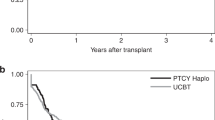Abstract
In the absence of a related donor, unrelated cord blood transplant (CBT) may be a potential option for patients with a primary immune deficiency (PID). Most published experience consists of single-center data using multiple preparative regimens and GVHD prophylaxis. We report the results of a multicenter prospective trial of unrelated CBT for PID. A total of 24 children with PID, with a median age of 1 year (range: 0.23–7.81 years) and a median weight of 10.5 kg (range: 4–24.4 kg) received unrelated CBT between 1999 and 2003. All patients received a fully ablative conditioning regimen with identical GVHD prophylaxis and supportive care. Most patients (79%) received a 1 or 2 HLA Ag-mismatched cord unit with a median nucleated cell infused of 9.3 × 107/kg (range: 1.0–31.2) and a median CD34 of 2.7 × 105/kg 2.9 (range: 0.6–84.5). The cumulative incidence of neutrophil engraftment by day 42 was 58% (95% CI: 38–79%) at a median of 19 days. Cumulative incidence estimates of grade III–IV acute GVHD at day 100 and chronic GVHD at 1 year were 29% (95% CI: 10–48%) and 24% (95% CI: 3–44%), respectively. The probability of survival at 180 days and 1 year was 66.7% (95% CI: 44.3–81.7%) and 62.5% (95% CI: 40.3–78.4%), respectively. Unrelated CBT should be considered in children with PID.
This is a preview of subscription content, access via your institution
Access options
Subscribe to this journal
Receive 12 print issues and online access
$259.00 per year
only $21.58 per issue
Buy this article
- Purchase on Springer Link
- Instant access to full article PDF
Prices may be subject to local taxes which are calculated during checkout


Similar content being viewed by others
References
Antoine C, Muller S, Cant A, Cavazzana-Calvo M, Veys P, Vossen J et al. Long-term survival and transplantation of haemopoietic stem cells for immunodeficiencies: report of the European experience 1968–99. Lancet 2003; 361: 553–560.
Diaz de Heredia C, Ortega JJ, Diaz MA, Olive T, Badell I, Gonzalez-Vicent M et al. Unrelated cord blood transplantation for severe combined immunodeficiency and other primary immunodeficiencies. Bone Marrow Transplant 2008; 41: 627–633.
Buckley RH, Schiff SE, Schiff RI, Markert L, Williams LW, Roberts JL et al. Hematopoietic stem-cell transplantation for the treatment of severe combined immunodeficiency. N Engl J Med 1999; 340: 508–516.
Grunebaum E, Mazzolari E, Porta F, Dallera D, Atkinson A, Reid B et al. Bone marrow transplantation for severe combined immune deficiency. JAMA 2006; 295: 508–518.
Kurtzberg J, Prasad VK, Carter SL, Wagner JE, Baxter-Lowe LA, Wall D et al. Results of the Cord Blood Transplantation Study (COBLT): clinical outcomes of unrelated donor umbilical cord blood transplantation in pediatric patients with hematologic malignancies. Blood 2008; 112: 4318–4327.
Prasad VK, Kurtzberg J . Emerging trends in transplantation of inherited metabolic diseases. Bone Marrow Transplant 2008; 41: 99–108.
Bhattacharya A, Slatter MA, Chapman CE, Barge D, Jackson A, Flood TJ et al. Single centre experience of umbilical cord stem cell transplantation for primary immunodeficiency. Bone Marrow Transplant 2005; 36: 295–299.
Knutsen AP, Wall DA . Umbilical cord blood transplantation in severe T-cell immunodeficiency disorders: two-year experience. J Clin Immunol 2000; 20: 466–476.
Sato T, Kobayashi R, Toita N, Kaneda M, Hatano N, Iguchi A et al. Stem cell transplantation in primary immunodeficiency disease patients. Pediatr Int 2007; 49: 795–800.
Toren A, Nagler A, Amariglio N, Neumann Y, Golan H, Bilori B et al. Successful human umbilical cord blood stem cell transplantation without conditioning in severe combined immune deficiency. Bone Marrow Transplant 1999; 23: 405–408.
Weisdorf DJ, Hurd D, Carter S, Howe C, Jensen LA, Wagner J et al. Prospective grading of graft-versus-host disease after unrelated donor marrow transplantation: a grading algorithm versus blinded expert panel review. Biol Blood Marrow Transplant 2003; 9: 512–518.
Fine JPGR . A proportional hazards model for the subdistribution of a competing risk. JASA 1999; 94: 496–509.
Tsuji Y, Imai K, Kajiwara M, Aoki Y, Isoda T, Tomizawa D et al. Hematopoietic stem cell transplantation for 30 patients with primary immunodeficiency diseases: 20 years experience of a single team. Bone Marrow Transplant 2006; 37: 469–477.
Wagner JE, Barker JN, DeFor TE, Baker KS, Blazar BR, Eide C et al. Transplantation of unrelated donor umbilical cord blood in 102 patients with malignant and nonmalignant diseases: influence of CD34 cell dose and HLA disparity on treatment-related mortality and survival. Blood 2002; 100: 1611–1618.
Baker KS, Filipovich AH, Gross TG, Grossman WJ, Hale GA, Hayashi RJ et al. Unrelated donor hematopoietic cell transplantation for hemophagocytic lymphohistiocytosis. Bone Marrow Transplant 2008; 42: 175–180.
Cooper N, Rao K, Goulden N, Webb D, Amrolia P, Veys P . The use of reduced-intensity stem cell transplantation in haemophagocytic lymphohistiocytosis and Langerhans cell histiocytosis. Bone Marrow Transplant 2008; 42 (Suppl 2): S47–S50.
Rao K, Amrolia PJ, Jones A, Cale CM, Naik P, King D et al. Improved survival after unrelated donor bone marrow transplantation in children with primary immunodeficiency using a reduced-intensity conditioning regimen. Blood 2005; 105: 879–885.
Acknowledgements
The Cord Blood Transplantation Study (COBLT) was conducted and supported by NHLBI in collaboration with the COBLT Study Investigators. This paper was prepared using a limited access dataset obtained from NHLBI and does not necessarily reflect the opinions or views of COBLT or NHLBI. This study was supported in part by Vanderbilt CTSA Grant UL1 RR024975 from NCRR/NIH.
Author information
Authors and Affiliations
Corresponding author
Rights and permissions
About this article
Cite this article
Frangoul, H., Wang, L., Harrell, F. et al. Unrelated umbilical cord blood transplantation in children with immune deficiency: results of a multicenter study. Bone Marrow Transplant 45, 283–288 (2010). https://doi.org/10.1038/bmt.2009.137
Received:
Revised:
Accepted:
Published:
Issue Date:
DOI: https://doi.org/10.1038/bmt.2009.137
Keywords
This article is cited by
-
Allogeneic Hematopoietic Cell Transplantation in Patients with Primary Immunodeficiencies in Korea: Eleven-Year Experience in a Single Center
Journal of Clinical Immunology (2018)
-
Umbilical cord blood banking: an update
Journal of Assisted Reproduction and Genetics (2011)



